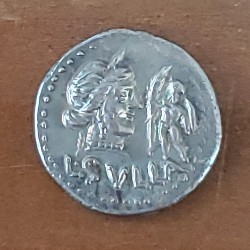 Sulla, denarius issue of 84-83 BC,
Sulla, denarius issue of 84-83 BC, possibly Crawford 359/2
Lucius Cornelius Sulla, issue of 84-83 BC.
Stack's, Sept, 10th, 2008, lot# 212
www.sullacoins.com/roman-republic
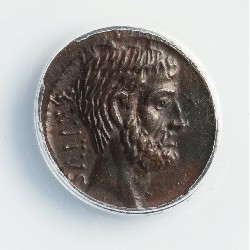
L. Iunius Brutus,
denarius, 54 BC
ANACS AU-50
Heritage, Sept 6th, 2023, lot# 61093
head of L. Iunius Brutus, money: same
weight 3.71 g
Brutus
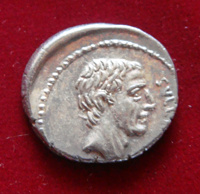
Lucius Cornelius Sulla,
denarius, 54 BC
Stack's, Sept, 10th, 2008, lot# 257
weight 4.160 g
Sulla was a victorious General in many of Rome's external conflicts, capturing Athens in 86 BC.
He became consul in 88 BC. He became an unlimited term Dictator in 81 BC after winning a civil war
against opposing Roman forces. He attempted to reform the Roman Republic during his Dictatorship
and then retired in 79 BC. Although he attempted to improve the Republic his example showed that
a strong general could obtain control and become an unlimited term Dictator.
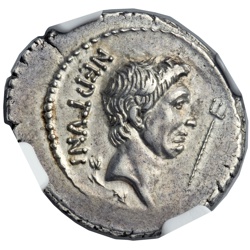
denarius, Pompey the Great,
struck under Sextus Pompey, ca. 44 - 43 BC
NGC Choice AU 4/5 - 5/5, Heritage Jan, 2016
Issue of Q. Nasidius, sub-commander of the Pompeian fleet, Massalia or Sicilian mint, ca. 44-43 BC. NEPTVNI, bare head of Pompeius Magnus right, dolphin right below, trident before / Galley (quinquereme) under sail to right, with multiple banks of oars, shields lining gunnels, heads of rowers and/or marines along deck, large figure (Sextus Pompey?) standing at prow pointing forward, six-pointed star in upper left field, Q NASIDIVS below. Crawford 483/2
21mm, 4.00 gm, 9hThe roller-coaster career of Sextus Pompey, youngest son Pompey the Great, spanned the dying years of the Roman Republic and its rebirth as an Empire. The large and varied coinage of Sextus Pompey employs numerous interesting nautical themes, in keeping with his claim to be the "son of Neptune." This attractive denarius belongs to the brief interval between Caesar's murder and Sextus' appointment as Praefect of the Fleet in April of 43 BC, during his sojourn at the Gallic port city of Massilia. The obverse portrait is clearly recognizable as Pompey the Great, although the legend identifies him as Neptune and provides him appropriate attributes- a dolphin and trident. The moneyer, Q. Nasidius, was a Pompeian loyalist who served both Magnus and Sextus as commander of the fleet until his defeat at Naulochus, whereupon he joined Antony's forces, only to suffer another naval defeat at Actium in 31 BC.
photos & writeup by Heritage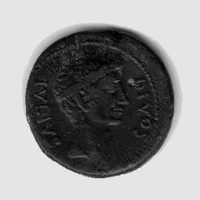
Julius Caesar (postumus)featured on
a sestersius/dupondius of Octavian
issued 38 BC
Numismatics Fine Arts, Auction xxviii,
Apr 23 1992, lot# 1060
This piece is unusual because the obverse and reverse legends are clear and legible.
Legend Rev: Julius the god;
Legend Obv:
Caesar Son of the God
I believe this is the
largest portrait of Julius Caesar on a coin, at least for those made in
ancient times. This coin was believed minted in southern Italy by Octavian.
Julius Caesar was a supreme general who used his power to overthrow the decaying Roman Republic. Caesar was his family name but later it became a title for future Emperors. He adopted Octavian as his heir. Octavian used Tarentum in southern Italy as his base port for his war against the conservative Republican-Allied forces of Sextus Pompey.
A discussion of these pieces is on Coin Talk:
New Octavian / Divus Julius bronze: CAESAR DIVI FILIUS
by Julius Germanicus
The OP is also available as a PDF & can be downloaded here:
Divus Julius bronze by Julius Germanicus

Brutus denarius
issued 42 BC
Leu Auctions, May 27th 2023, lot# 206
Brutus, military mint traveling with Brutus & Cassius in Western Asia or Northern Greece
late summer or autumn, 42 BC.
Crawford 508-2.
Crawford 2nd edition supposedly has lesser plate quality than the rarer & more expensive 1st ed. I figured I could always compensate for the plates with online images and it has additions & corrections to the 1st ed.

Octavian Caesar as shown on a denarius
issued 31 BC by Marc Antony
Exf condition
(coin store, New Orleans, LA)
Rev: Portrait of Octavian
After he formed the Principate in 27BC, Octavian took the name "Augustus". He is is technically the 1st Roman Emperor as Julius was assassinated before he had that title.